Sliding requirements
Question
QUESTION: Where is the rule (NFHS) that requires a base runner to slide if the defensive player at the base or plate has possession of the ball. We are going to play in a tournament where the director ruled that you do not have to slide (he says it says it clearly in the rule book) and you are only out if the contact is malicious and then you can also be ejected. I have found each of these, but am 99.9% sure that the runner is out if they run into the fielder at the base and they are in an upright position.
ANSWER: You won't find any rule regarding a requirement to slide in the NFHS rule book. This is because a runner is never required to slide. This tournament director is correct.
---------- FOLLOW-UP ----------
QUESTION: Sorry, should have explained the situation that occurred. Runner on second with less than two outs. Ball is hit back to the pitcher. The pitcher checks the runner who is running to second and throws to third. The runner is thrown out by two or three steps and elects not to slide. However, when the third baseman makes a low tag anticipating the slide, the runners foot kicks the ball out (not on purpose or maliciously). The answer I got on here was that she was not required to slide, but she would be called out for being in an upright position while colliding with a defensive player in possession of the ball. I can't find that rule specifically stated in the book.
ANSWER: F5 needs to do a better job of hanging onto the ball.
Malicious contact is defined in the rulebooks as contact with excessive force. No malicious intent needs to be determined by the umpire. Describe the collision at third in more detail. Where did the players end up? Was F5 run over?
The reason you can't find that rule in the book is because it doesn't exist.
---------- FOLLOW-UP ----------
QUESTION: The third baseman is knocked down and ball falls out of glove just 1 foot away. The runner was not intending anything malicious, she was just a bigger player who got caught clumsily between sliding and not and failed to get down. The answer I originally got was "you can not run upright into a player at the base waiting for the tag." I think it may have been Mark who said he would call it interference. Otherwise, you would have many non-malicious collisions. Like you, I can not find it spelled out in the rule book. Is it an interpretation or inference. I think I have seen it in answers more than once on the site but I could be wrong. Thank you for responding quickly, we leave tomorrow.
Answer
This could be called interference, this could be called nothing. It is definately one you have to see. Although you won't find it in the book, it is a bad idea to "run upright into a player at a base waiting for the tag". You leave to many options for the umpire to call you out and possible eject you from the game. If you run into the player without sliding while they are waiting to make the tag, and you make enough contact to knock them down and drop the ball, you likely have an interference call.
Although it is never required, legal slide will always be judged by the umpire as an attempt to avoid a collision.
Travesty of the Game?
Who won?


